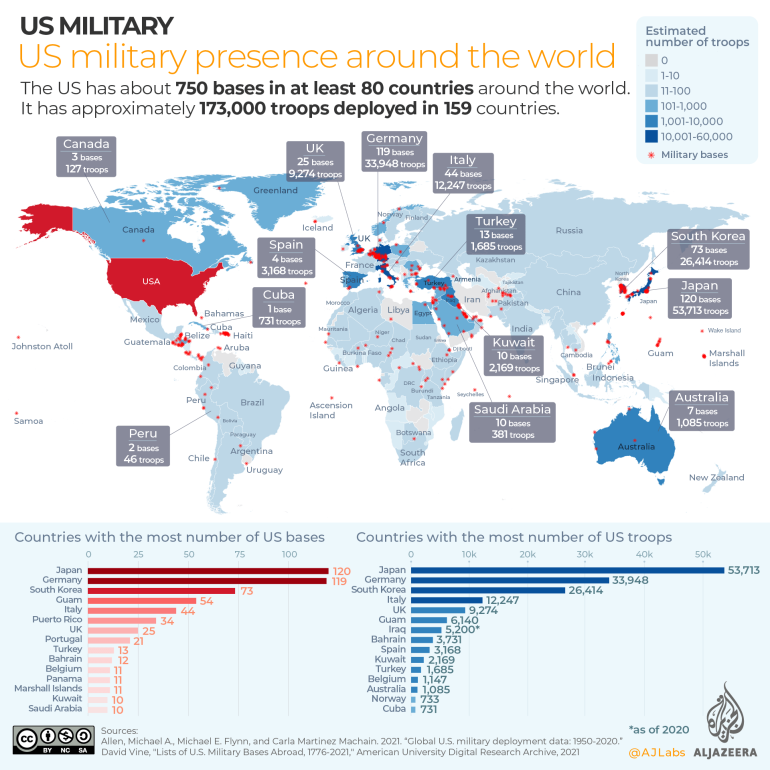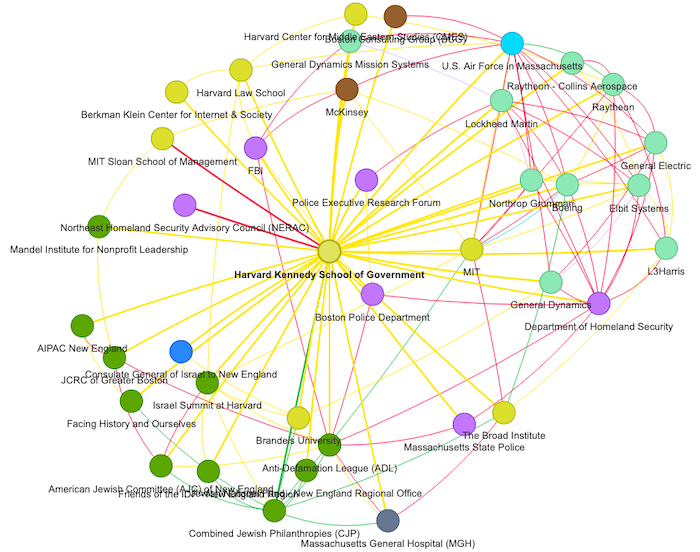We bring to the attention of our readers this essay by the late Professor André Gunder Frank, one of the World’s leading and most distinguished political economists. First published by Global Research in 2004.
From the very outset in 2001, André Gunder Frank was a firm supporter of the Global Research Project. He was a lifelong friend and mentor. He passed away in 2005. His legacy will live.
Frank analyzed the broad relationship between militarisation and the crisis of the US dollar as a World currency, a key relationship which characterizes today’s global crisis.
 Published 18 years ago, this incisive essay provides a perspective on the evolving New World Order, its structural weaknesses and contradictions.
Published 18 years ago, this incisive essay provides a perspective on the evolving New World Order, its structural weaknesses and contradictions.
Prof André Gunder Frank
This essay consists of the following parts:
Coup d’ État in Washington
Paper Tiger – The United States and the World
Fiery Dragon: China in East Asia
Michel Chossudovsky, May 4, 2018, June 7, 2022
***
Political Background
Recent events in Iraq that require no further elucidation here make this essay now more timely than when it was written.
For this essay is a combination of two related articles:
First, my earlier paper focusing on the 2000 [Election] Coup d’Etat. This paper related to the illegitimacy of the Bush government and the long standing agenda of the Cheney group which has made another Coup within the Bush Coup.
Secondly, my paper on the paper tiger, concerning the underlying Achilles heels vulnerability of American power that rests only on the paper dollar and the military Pentagon.
Vice President Gore’s major speech damning the policy of the Bush administration and calling the President himself incompetent, as he surely is, nonetheless judiciously avoided any direct mention of the illegitimacy of the president and his administration.
Bush’s presidency was derived from a veritable coup d’ Etat, not in having lost the popular vote, but first in having also lost the vote in the key state of Florida and “won” it through fraud and violence.
And then they violated the fourteenth amendment of due process through the stacked vote in the Supreme Court and its refusal to let anybody abide by due process.
 Moreover, not only did Dick Cheney manage the entire transition to and construction of the Bush administration, but as Vice President he has continued to run the President’s show from behind the scenes.
Moreover, not only did Dick Cheney manage the entire transition to and construction of the Bush administration, but as Vice President he has continued to run the President’s show from behind the scenes.
That is so much so that after their joint three hour testimony to the 9/11 commission about their Iraqi malfeasance, the New York Times was moved to editorialize that it made evident that the President is no more than a puppet managed by the Vice-President.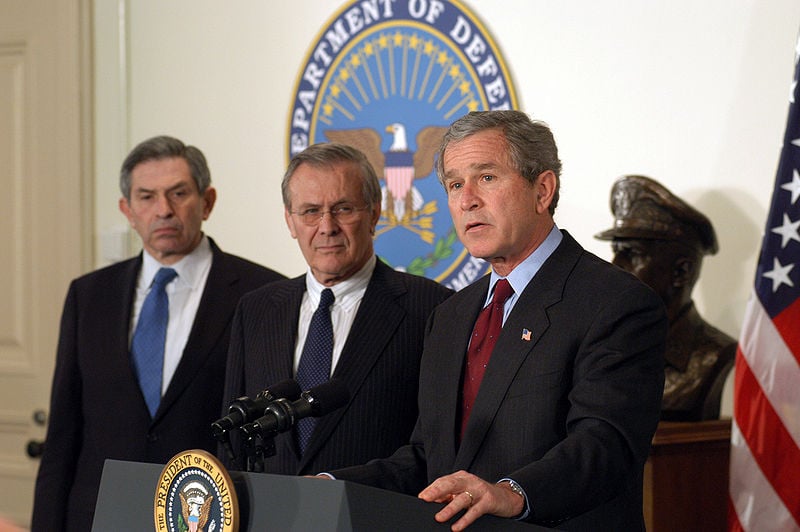
And as we know and the coup part of this essay further documents, the Vice-President himself was captured and molded to its own ends of long standing by a team of the PNAC – Program for the New American Century – maniacal adventurers, led by “Wolfowitz of Arabia.”
This illegitimacy of the President and his administration’s inauguration now takes further significance with the revelations that after having lied to the electorate, they have continued to lie and mislead the American public and the world regarding the State of the Nation and that of the world, as well as with regard to the devastating impacts of their foreign and domestic policies.
The documentation is overwhelming, but not even the tip of the iceberg is yet emerging that the Administration and President Bush himself have consistently lied and covered up about September 11, 2001.
They have lied about security and have deliberately weakened it and have themselves terrorized the American public, not to mention that they have torn the Bill of Rights to shreds and otherwise have violated the Constitution.
By sending the machine gun toting National Guard into every airport in the country, they are every day violating the Posse Comitatus Act that prohibits military participation in domestic civilian affairs that has stood since 1878. They have also violated a more recent law prohibiting the CIA from doing so as well. All this only to scare the public and Congress into accepting their unconstitutional Patriot Acts and other measures from the agenda of a small right minority.
And of course they have perpetrated monstrous lies about their war against Afghanistan and now against Iraq.
Thus, an illegitimate president who promised “gentle conservatism” has instead taken the most radical departure of militarizing American society at home, privatizing the US Military abroad, and antagonizing the rest of the world by his unilateral militarism and anti-environmentalism, not to mention his administration’s befuddled ‘’justification.”
His and his government’s verbal denunciation combined with de facto generation and sponsorship of terrorism is wearing thin and has in a totally irresponsible fashion led them and us into a Catch 22 damned if you do, damned if you don’t debacle.
The one in Iraq demonstrates one of several underlying vulnerabilities of American reliance on the Pentagon.
The Paper Tiger Dollar
As this essay argues, this military Achilles heel also further weakens the other one, which is based on the paper tiger dollar. That has declined in value against the Euro and the Yen since I first wrote about this threat and how it in turn would weaken the Pentagon that must be financed by devalued dollars, especially in its increasing ventures abroad.
At the same time, while the revelations and soul searching about American torture in Iraq – and now we know long since also in Afghanistan and Guantanamo – the US occupation in Iraq is proceeding relentlessly with its major agenda there: OIL and the economy.

The Cheney sponsored oil pipeline through Afghanistan that the Taliban was supposed to implement but was unable to guarantee, thus converting it from friend to enemy, is now in the hands of the new American appointed government in Kabul.
In Iraq, it is yet difficult to tell WHAT the US occupation is doing – nobody even bothers to look beyond the torture any more – about the oil and the economy, other than that they are being privatized and sold off at bargain basement prices to big American companies, with Vice President Cheney’s Haliburton in the lead. He still derives income from it, although his super-hawk friend Richard Perle resigned his high Defense Dept position so that his conflict of interest would ‘’not hurt the President’s re-election chances.’’
Meanwhile President Bush himself defends giving a near monopoly of contracts for ‘’re-building Iraq’’ to US near monopolies on the grounds that ‘’WE’’ put our lives on the line and so are we legitimately entitled to the economic rewards there from.
But more important, with the region’s second largest oil deposits in Iraq , what is the US really doing there on the world oil market and its efforts to control or break OPEC?
One thing is sure, and the oil section of the paper tiger part of this essay speaks to this issue:
Iraqi oil is again being priced in US dollars and no longer in Euros as under Saddam Hussein.
In the meantime also, the dollar has indeed fallen significantly against the Euro and the Yen. This devaluation of the dollar would at least make US industrial and agricultural products more salable on the world market – if they were otherwise competitive. But the industrial ones are not and the agricultural ones thrive only thanks to the huge government subsidy, the same as in Western Europe and Japan.
On the other hand, a devalued dollar makes the US less attractive for the continued inflow of foreign capital from overseas savings on which the US economy and the American standard of living and way of life is so vitally dependent.
All presidential administrations have lied to the American public about the sources of their well being that are allegedly based on American efforts and skills promoted by healthy government domestic and foreign economic policies. But nothing could be further from the truth.
The Clinton boom years of the 1990s – after the 1989-92 recession – were based entirely on the suction and flight of capital first from the former Soviet Union and Eastern Europe who were forced into a depression far deeper than that of the 1930s and after the financial crisis of 1997 in Southeast Asia that was deliberately sponsored by Larry Summers, now President of Harvard but then at the World Bank and the US Treasury.
That resulted in declines of income by 40 and 50 percent and the deliberately managed misery and death of millions in East Asia – and the flight of their own and foreign speculative capital to the US safe haven of Treasury certificates (where it permitted a sudden but temporary balanced budget) and into Wall Street. There it fired the bull market that attracted Main Street to invest in Wall Street and made Mr. And Mrs. America feel rich and able to spend – also on $ 100 billion of excess imports of textiles and gadgets from China.
The Chinese in turn also sent the dollars they earned thereby back to Washington to buy Treasury certificates, so that the poor Chinese are by now the world’s largest creditors to the rich Americans.
More recently however, China has begun to import more itself, in particular from Southeast Asia and using it’s American earned US dollars to get at least something more that worthless Treasury certificates on which the US is bound to default, because it will be neither able nor willing to make good.
All depends on how long the rest of the world is still willing to put up with the US dollar as the world currency and what alternatives thereto there are. And this brings us back to the Pentagon as a shaky support for the dollar and the Iraq debacle as yet another chink in the rusty armor of confidence in the US in general and its money in particular.
And it leads us forward to examine the expanding role in the world of China, whose ten percent annual economic growth has been duplicating income every six years and making it a, and soon perhaps the, major player in the world economy.
What is the basis and security of the United States position and power in the world? The answer is the twin pillars of the Dollar and the Pentagon.
The dollar is a paper tiger – literally so, much more than when Mao applied this term to the US. The Pentagon’s strength and mobility is dependent on the dollar, which in turn is supported by US military might. But these two supporting towers of the US are also its two Achilles heels. Through them, like the twin towers of the World Trade Center in New York, the entire US edifice can come crashing down in one morning – not by terrorism but through the operation of the world market economy and the foolish policies of the United States government itself.
With the end of the cold war in 1989 and the subsequent decline of Russia as a serious immediate contender, as well as the decline during the 1990s of the hype of JAPAN AS # 1 [Vogel 1979] two other regions, states and powers came into contention.
They are the United States whose fortunes and prospects seemed to have declined after 1970 but recovered in the 1990s; and yet it is a paper tiger.
The other is the rising Fiery Chinese Dragon In global terms, we could regard this as a process of continued shift of the world center of gravity west-ward around the globe, from East Asia/China to Western Europe, then across the Atlantic to the United States, and there then from the eastern to the western seaboard, and now onwards across the Pacific back to East Asia, as observed in my “Around the World in Eighty Years” [Frank 2000]. Let us inquire further into the so far last part of this historical process.
Coup d’Etat in Washington
Be wary of conspiracy theories, beware of real conspiracies, and be aware of a grab of power.
It has happened in Washington and its instigators are pursuing a policy of (several) faits accomplis that attracts ever more people to jump on the band wagon. The Busch administration has made a real Coup d’Etat and achieved its apparently unknowing acceptance by America and the World. Even Hitler and Mussolini came to power by electoral routes and Stalin and Latin American dictators had to resort to violence to make their coups d’etat. Bush and his small coterie required none of these to get to the seat of power.
“The Coup”: Bush’s Accession to the Presidency
To begin with, Bush’s accession to the Presidency was in violation to the Constitution. It is not that he received a minority of the popular vote, because the Constitution provides for the President’s election by the Electoral College. But Bush received the Electoral College vote by fraud, for he lost the decisive popular and thereby electoral vote in Florida. His brother Jeb as Governor of Florida with the help of Mrs Harris as Secretary of State first deprived hundreds of thousands of African American and presumably Democratic voters of the vote through incarceration, intimidation, and other means.
The Republican Cuban Mafia sent its goon squads physically to prevent a recount in Broward County. Mrs. Harris did all she could, which was plenty, to interfere with recounts in other counties in Florida. The alleged recounts that were made were a sham. They only recounted votes that were NOT counted in the first count by voters who had been unable to punch holes all the way through the voting cards without leaving the infamous hanging chads.
Yet much more importantly one either before the decision or afterwards when the newspapers did it again, NO one ever recounted the votes that HAD been for the Democrats but were discounted because voter mistakenly also punched a second hole on a confusing ballot. Yet even the third and most conservative candidate Pat Buchanon declared publicly that these duplicate votes in heavily Jewish and Democratic counties were surely not for him but for the Democratic Party candidate. These votes [or even half of them if they had been allotted also to other candidates] would have given a decisive majority of the popular vote and therefore of the Electoral College votes in Florida to the Democrats. Yet they were never counted or recounted for the Democrats.
In the end Bush was not elected, but was SElected in the Supreme Court by the decisive political swing vote of Justice Kennedy. The Supreme Court’s appeal to the 14th amendment, which guarantees due process of Law to all, was ironically biased. For it was selectively applied without due process to squash the popular vote in Florida, but the same due process procedures were not applied to challenged votes in any other State. That in itself was already a de facto coup d’ Etat.
Then, several members of the House of Representatives called for a challenge of the Electoral College under Constitutional provisions that permit the Congress to do so if the challenge has the support of at least one member of both houses. Yet they were not joined by even a single Senator, who would have made the challenge legally effective. In other words, the Congress simply acquiesced to this power grab by the Bush administration through a Coup d’eat with the help of the Supreme Court but in clear violation to the Constitution.
That was the beginning of the violation of the Constitutional separation of powers and checks and balances. Since then, the Bush administration has carried these violations farther than any previous one in the history of the United States. Not even President Lincoln in the Civil War, nor President Roosevelt in the Second World War nor his previous attempt to stack the Supreme Court, ever grabbed and concentrated as much power for the executive branch while marginalizing the Legislative branch and the Judiciary.
Beware of Conspiracy Theories. But be aware that it was really Vice-President elect Dick Cheney who then put together the Bush Administration, selecting whom to place in which positions of power, especially in defense affairs.
The PNAC
 And beware of PNAC, the Project for a New American Century, which was already lobbying Washington with their plans for a “Pax Americana” in 1992, 1997, and 2000 among other notable dates.
And beware of PNAC, the Project for a New American Century, which was already lobbying Washington with their plans for a “Pax Americana” in 1992, 1997, and 2000 among other notable dates.
PNAC issued a long report in September of 2000 entitled “Rebuilding America’s Defenses: Strategy, Forces and Resources for a New Century.”
Its statement of principles calls for a massive increase in military power, U.S. military domination of Eurasia to prevent the rise of hostile powers; and pre-emptive [not just pre-ventive] military action against states suspected of developing weapons of mass destruction.
PNAC’s prescriptions have been converted into official US policy and praxis by the Bush Administration.
 PNAC founding members and signatories of its statements include;
PNAC founding members and signatories of its statements include;
- Cheney himself,
- Lewis Libby, Cheney’s top national security assistant and now the Vice-President’s chief-of-staff
- Donald Rumsfeld, also a founding member, now Secretary of Defense
- Paul Wolfowitz [of Arabia], now Deputy Defense Secretary and arguably the groups ideologue
- Eliot Abrams, pardoned by Bush Sr. in the Iran/Contra scandal and now member of the National Security Council
- John Bolton, Undersecretary for Arms Control and International Security
- Richard Perle, the most outspoken hawk in the Reagan administration who advocates dumping the United Nations, then chairman of the powerful Defense Policy Board, who was forced to resign one of his positions over a conflict of interest scandal,
- Randy Scheunemann, President of the Committee for the Liberation of Iraq, who was Trent Lott’s national security aide and who served as an advisor to Rumsfeld on Iraq in 2001
- Bruce Jackson, now Chairman of PNAC and former vice president of weapons manufacturer Lockheed-Martin who headed the Republican Party Platform subcommittee for National Security where he called for – as had Wolfowitz for some years – the removal of Saddam Hussein
- William Kristol, noted conservative writer for the Weekly Standard, a magazine owned along with the most hawkish Fox News Network owned by Ruppert Murdoch
- Norman Podhoretz, editor of the right wing New Republic
- and others, like Norman Kaplan and Douglas Feith.
The core group of the PNAC now hold the highest positions of policy making power in the Pentagon and much of it in the White House.
They have also planted one of their group in the State Department to keep an eye and check on Colin Powell who is the only major foreign policy player who is not a member of this inner sanctum.
An interesting sidelight is that Wolfowitz, Perle and Feith also went to Israel to serve as advisors to Prime Minister Ariel Sharon, for whom they drew up a battle plan against the Palestinians. Behind them lies the strange ideological bed-fellow political alliance of two of the most powerful lobbies in the United States: Organized Zionism and Christian Fundamentalism. For good measure, throw in the Cuban Mafia as well.
Another matter to consider are some of the connections of these same people with the private sector. Two examples should suffice to give a general idea. Cheney was chairman of Halliburton Inc., which in turn owns Brown & Root and other habitual contractors of the Defense Department for major construction and/or petroleum projects around the world.
One of these companies was awarded a 1 Billion dollar contract to re-build the Iraqi oil fields in case they should be damaged in the war. Another, of which the now “Prime Minister” of Afghanistan was a former employee, namely UNOCAL, is first in line to build the proposed oil and gas pipeline across Afghanistan from Central Asia to the Indian Ocean. The Bush family and George W. Bush himself have long standing business relations with the Carlyle Group, which also represents the Bin Laden family (including Osama), with whom they have also maintained direct relations.
The White House and the Executive Branch generally has made full use of its new power to serve its economic and political allies.
Those who made the largest campaign contributions have been handsomely rewarded with government hand-outs and regulations, or rather de-regulation. The Bush administration has issued at least 200 separate executive orders to roll back regulations enacted by previous administrations, even Republican ones, to protect the environment and/or Public Health and Safety. Executive Order has received a whole new meaning: Special interests write an order that is passed to the President for his signature, whereby mostly without knowing what he is doing he converts it into an Executive Order.
The Pentagon has petitioned the White House to exempt it from existing environmental protection regulations that hamper their disposal of spent munitions and other hardware and thereby interfere with ‘’national security. ” The President deliberately appointed as Secretary of the Interior a person known for her ties to the timber and oil industries to whose exploitation she seeks to open thousands of acres of federally owned lands as well as the Alaska Wilderness for the construction of a new pipe-line – all in the interest of course of ‘’national security.”
The Bill Of Rights and the Constitution
More serious still, the Bush administration has shredded the Bill of Rights, abrogated the Constitution, and even violated the age – old common law of Habeus Corpus, which prohibits the detention and holding of anybody against his will without due process of law.
Elsewhere in the Executive Branch, President Bush appointed and lent full support to Attorney General John Ashcroft who was already known for his racist and authoritarian inclinations. Although many Senators had doubts about his appointment, the Senate ratified it anyway. Since then, Attorney General Ashcroft and his staff have converted several arms of the Department of Justice into those of a police state. The Executive has encouraged and permitted the Attorney General and the Department of Justice Judiciary Branch to violate the Bill of Rights and the Constitution on multiple counts. For instance, the US Government already claims the right to monitor all e-mail and to bug telephone conversations without specific judicial permission.
The Bush Administration brought Admiral Pointdexter back into government after his participation in the Iran-Contra Scandal and lyiung about it to Congress. His new mission is a project, called Total Information Awareness Project (TIAP): to develop computers to monitor “vast quantities of data generated by US civilians in their daily lives: Academic transcripts, ATM receipts, prescription drugs, telephone calls, driving licences, airline tickets, parking permits, mortgage payments, banking records, emails, website visits and credit card slips” [The Guardian November 23, 2002].
In critique of all this and the Patriot Act, only the lone voice in Congress of Representative and presidential candidate Dennis J. Kucinich (D-Ohio) has asked
“How can we justify in effect canceling
- the First Amendment and the right of free speech, the right to peaceably assemble?
- the Fourth Amendment, probable cause, the prohibitions against unreasonable search and seizure?
- the Fifth Amendment, nullifying due process, and allowing for indefinite incarceration without a trial?
- the Sixth Amendment, the right to prompt and public trial?
- the Eighth Amendment, which protects against cruel and unusual punishment?
- And Justice for All?”
The Constitution makes all the rights it guarantees extensive to anybody in the US, but the Attorney General has declared that non- citizens are not worthy of protection by the Constitution.
We do not know yet how much of a loss that is because the Department of Justice and its Immigration and Naturalization Service[INS] have also taken it upon themselves also to divest naturalized and even native-born American Citizens of their citizenship, again in clear violation of the Constitution.
And even those who remain citizens are under constant threat to have their rights violated without due process under the fourteenth amendment, or to be detained in violation of Habeus Corpus.
They are denied representation by legal counsel and trial in civil courts, as provided for by the Constitution. In particular, hundreds of thousands of American residents and Citizens of Arab descent or even of features that appear to individual agents of the Department of Justice or the police’s racial profiling as perhaps being Arab, or Muslim, or who knows what else have been called in for questioning. When they appeared in Los Angles, they were detained without charge. They now live in constant fear of the infamous knock on the door at 3AM that was made infamous by Hitler’s Gestapo and Stalin’s GPU. That is so if they are even favored by a knock on the door before a blast of gunfire of shooting first and asking questions later.
So far as we know of over 700 people who have remained in detention since September 2001; though there may be many more, since nobody knows or says where they are, or who they are, or what they are accused of. Indeed, only a dozen of these have ever been charged with anything. The others remain out of sight and out of mind except for their families who are not allowed even to secure legal representation for them. So do the innocent Afghani prisoners the US keeps in in Guantanamo and the countless ones still detained under horrible conditions in Afghanistan. How come there is no public outcry about any of these?
On the other hand, the same Executive Branch has divested the Judiciary of powers and the citizenry of judicial protection by illegally transferring powers of the Judiciary to itself. Perhaps only the most visible tip of the iceberg of this process is the Bush Administration and Pentagon declaration that it will bring normal civil suits before military tribunals that operate under rules of court marshal and other procedures of Military “Justice” that can order death sentences without appeal. Moreover, the accused do not know whereof, cannot chose legal counsel, and their conversation with whom can be overheard by the authorities. The prestigious very conservative publicist William Saffire refers to them as ‘’kangaroo courts” and observes that “no longer does the judicial branch and an independent jury stand between the government and the accused.
In lieu of those checks and balances central to our legal system, non-citizens face an executive that is now investigator, prosecutor, judge, jury and jailer or executioner. In an Orwellian twist, Bush’s order calls this Soviet-style abomination “a full and fair trial.”
The Land of the Free?
John Ashcroft has also issued instructions to the Department of Justice to resist as far as possible the delivery of documents under the Freedom of Information Act.
And the Executive itself has severely restricted the kind and number of documents of its own that it is prepared to make public. In other words, transparency and therefore control or even critique of the ever widening powers and their use by the Executive Branch is itself being severely restricted.
On the other hand, the Executive Branch has multiplied its own access to information. During the congressional debate on John Ashcroft’s USA Patriot Act, an American Civil Liberties Union fact sheet on the bill’s assaults on the Bill of Rights revealed that Section 215 of the act “would grant FBI agents across the country breathtaking authority to obtain an order from the FISA [Foreign Intelligence Surveillance Act] court . . . requiring any person or business to produce any books, records, documents, or items.” That includes bookstores and public libraries being obliged to divulge who is reading what. This is now the law,
Alas, the Congress has been intimidated into passive acceptance of virtually everything and anything the Executive proposes and demands. It passed the Patriot Act that severely restricts civil liberties virtually without reading it.
The proposed Patriot Act # 2 has not even bee submitted to the Congress for study and yet the version leaked by the Press suggests that it proposes even more of a police state than the first one. When the Leader of the Democratic Majority in the Senate voiced only the mildest doubts about Bush’s military moves, he was immediately reprimanded by his Republican Majority Leader counterpart Lott, for ‘’how dare he criticize the President in time of war!” Both have been forced to resign since then, but for scandals unconnected to that one.
Moreover, the Executive has been more than secretive about the events and circumstances of September 11, 2001; and the Congress has not launched any serious inquiry of its own. Neither have the Media. There has not even been any public inquiry or disclosure into the failure of the Air Force or National Guard to scramble fighter aircraft to investigate the airliners that had clearly gone off course. That is every day routine standard operating procedure, but it was called off or at least not enacted during the 90 minutes that elapsed between the crash into the first World Trade Tower and the one into the Pentagon – that is IF the Pentagon was damaged by an aircraft which has been seriously questioned if only because no evidence has ever been made public for such an occurrence.
Nor has the government given any account of its receipt and disregard of multiple forewarnings from intelligence agencies among its allies in Pakistan, Russia, Germany, France, Israel. In other words, the very circumstances that allegedly require all these domestic and foreign responses by the Bush Administration are themselves wrapped in a shroud of self-imposed secrecy.
The violation of the Constitutional provisions for the separation of powers is particularly flagrant regarding the powers reserved to the Legislative Branch of the Congress and the Constitutional prohibition against military action in domestic civil affairs.
Bush also disregards the Constitutional provision that only Congress may declare war, and it violates the 1976 War Powers act that Congress passed to regulate that Constitutional provision after it had been grossly violated in the Vietnam War. The Bush administration has de facto-also abrogated the 1878 Posse Comitatus Act that prohibits military participation in the enforcement of civil law, and it violates the general Constitutional provision against the military action in domestic affairs.

A US tank convoy during the Vietnam War (Source: Wikimedia Commons)
Instead, the Bush Administration has visibly mobilized the Armed Forces and National Guard around all US airports and elsewhere, and the Pentagon is drawing up plans for its intervention in endless domestic affairs. It stands to reason that the machine gun toting military presence in the passenger areas of airports has not added one iota to security but serves only to terrorize the public into blind and passive acceptance of the violation of their civil rights there and elsewhere.
Even the government has stated repeatedly that any other terrorist attack on the US is not likely to copy that of September 11, 2001 but to take totally different forms against which this military presence would offer no defense. Indeed, it would not have prevented that of September 11 either. The pretext that the country is at war is being used as cover for US government terror of its own at home and abroad; and the country is being militarized as never before, not even in war time.
The Pentagon is extending its actions in American Civil Affairs ever more, also by establishing a new office of Under Secretary of Defense for Homeland Security, which then created a northern command to coordinate military response to domestic threats. The Pentagon also has a new Under Secretary for Intelligence,
Stephen Cambone, who said the existing agencies will continue with their work but that his unit will ensure that they are meeting the intelligence needs and priorities laid out by the Pentagon, also at home. [Boston Globe June 8, 2003].
Pax Americana
The Pentagon is also expanding into previously unimagined places and roles overseas. There are now well over 100 US military bases around the world. and current US military operations in Iraq, Afghanistan, the Horn of Africa, Colombia, the former Yugoslavia, South Korea, the Philippines, and former Soviet states such as Georgia.
The latest details, disclosed by the Wall Street Journal on June 10th 2003, include plans to increase U.S. forces in Djibouti on the Horn of Africa across the Red Sea from Yemen, setting up semi-permanent “forward bases” in Algeria, Morocco, and possibly Tunisia, and smaller facilities in Senegal, Ghana, and Mali that could be used to intervene in oil-rich West African countries, particularly Nigeria.
Similar bases–or what some call lily pads–are now being sought or expanded in northern Australia, Thailand, Singapore, the Philippines, Kenya, Georgia, Azerbaijan, throughout Central Asia, Poland, Romania, Bulgaria, Qatar, even Vietnam, and Iraq. [Needless to say that the construction of these military bases constitute lucrative multimillion contracts for US corporations including Bechtel and Halliburton. (Edtor)]
The new republics in former Soviet Central Asia and the former Soviet satellite states in Eastern Europe are a particularly strong magnets for U.S. military presence, and a glance at the map will show that the US is systematically encircling China. Moreover, the Pentagon military missions are marginalizing the State Department diplomatic ones, with the senior military officer having more resources and greater influence than the US ambassador [Boston Globe, June 8 2003].
Even so, the Associated Press reports on February 24 that
” senior U.S. officials have been quietly dispatched in recent days to the capitals of key Security Council countries where they are warning leaders to vote with the United States on Iraq or risk “paying a heavy price.”
Although this kind of blackmail has been SOP in all American administrations, the Bush Administration has carried the threat and practice to previously unheard of new heights. As President Bush declared in his State of the Union address “Those who are not with us, are against us” – and will pay a heavy price.
“We are in the process of taking a fundamental look at our military posture worldwide, including in the United States,” said Deputy Defense Secretary Paul Wolfowitz on a recent visit to Singapore, where he met with military chiefs and defense ministers from throughout East Asia about U.S. plans there. “We’re facing a very different threat than any one we’ve faced historically.” But recall that this is the same Wolfowitz of Arabia talking who drew up his and PNAC’s plans to face this different threat already in his memos of 1992, 1997 and 2000.
The Law of the West
The Bush administration has also set aside centuries of International law. It wages illegal war, prohibited by numerous international treaties and by the United Nations Charter. Indeed it makes war without even declaring it, which even Hitler took the trouble to do.
The US armed forces wantonly violate Geneva conventions of crimes against humanity, genocide, weapons of mass destruction such as depleted uranium, cluster bombs, massive ‘’Daisy Cutter” bombs, destruction of civilian facilities to provide as power, water, and sanitation, and even neutral international waterways as when it deliberately blocked shipping on the Danube.
The Bush Administration (though Presidents Clinton and Bush Sr. also already earlier) have completely emasculated the United Nations instruments and procedures set up by the US and its allies after World War II to preserve the peace. Bush even had the gall to go to the UN and charge it with dereliction of duty and of its reputation by failing to give its stamp of approval for his War against Iraq – when the clear duty of the UN and especially of its Security Council is not to make war but to keep the peace.
His government and his lackey press mislead the public into believing that a Security Council resolution could legalize his war. The fact is that even with a SC resolution, his father’s War against Iraq in 1991 was in clear violation of Articles 2, 27, 41, 42, 43 and 53 of the UN Charter, among others.
The NATO states and President Clinton failed even to consult the UN before going to War against Yugoslavia. Then the present President waged War against Afghanistan without the slightest provocation from its government, without UN approval. And then it made War on Iraq in clear violation of the expressed desires of the UN membership. What this illustrates is the total abandonment of the UN as an institution and instrument for peace.
The demise of the UN as an International Body
After the US bombs a country into shambles, it then goes to the UN to ask it to pick up the pieces, or in plain English allegedly to legitimize the US military occupation of the country it had just destroyed.
But not only that, the violation of international law also constitutes ipso facto a violation of national law, because Senate ratification of an international treaty converts it into US law as well. Moreover, domestic democracy has been sacrificed to waging international war as well, as when NATO did so against Yugoslavia without even a single member country government troubling itself to ask its parliament or Congress for authorization to do so.
In a word, the US has replaced existing International law by new Law IN the West on the model of its own old Law OF the West. Then in the 19th century, vigilante lynch mobs formed ad hoc to go hang whomever they wanted; and now the US is imposing this Vigilante “Law” on the rest of the world by force. And as the vigilantes bought off or terrorized the sheriff and the judge to ‘’legitimize” themselves, so is the US, doing the same world wide in the real world, following the scripts of fictitious Spaghetti Western movies.
The Media
And what of the Fourth Estate – the Media?
They are strictly the mouthpiece of the Administration.
Note their behavior at White House, State Department, or Pentagon news conferences. All their questions are limited to technicalities about the implementation of Administration policies that are themselves accepted as cartes blanches.
Never ever has any representative of the US media posed a question that challenges the basis of the official policy in even the most timid way.
Indeed, not only what the press says or does not say reflects the policy and press- releases of the Administration. The very Media selection of what is or is not ‘’news,’’ e.g on the 6.30 pm Evening News of ABC, NBC, CBS, CNN, Fox, and shame on PPS for carrying the just as bad Jim Lehrer News Hour, is a simple reflection of what the White House or the State Department have declared to be ‘’news’’ that morning.
No matter how world shaking an event, if it has not shaken the piper, it does not merit mention by the media. But whatever the White House or the State Department declares to be news IS news. And even they have been obliged to make an agonizing reappraisal , albeit still only partial, of their own, after the revelations of torture of Iraqis has cast a shadow on their previous glowing reports about bringing democracy to them.
Their pieces in the press are little better. In a survey of op-eds in the Washington POST over four months, Russell Mokhiber and Robert Weissman found twice as many columns for as against the war, and in February 2003 the count was 24 in favor and 10 against, while the POST itself brought 9 editorials of its own to support the war. And that was regarding a war that had the highest popular opposition ever.The TV and radio talk shows are even more dominated by defenders of Administration policy. No matter that the Administration cooks, blends, massages and even simply invents the news; as is finally emerging regarding the non-existent weapons of mass destruction, which were the alleged reason for waging War against Iraq.
The Home of the Brave from 1984 to 2003
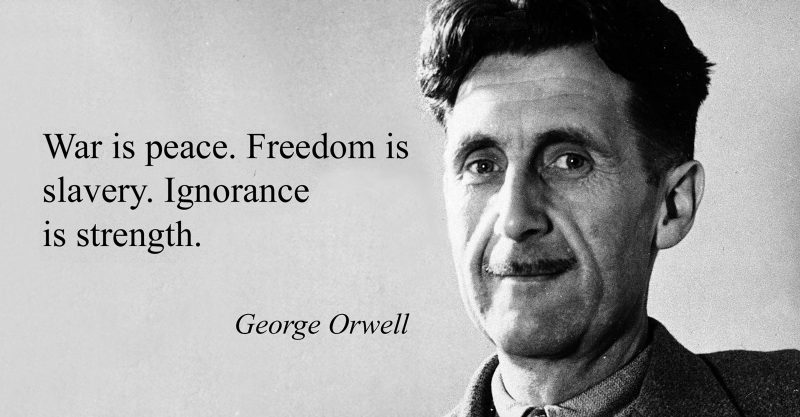 George Orwell would have to regard his dire predictions of Big Brother for 1984 as a benign Alice in a charming Wonderland version of Animal Farm. The latter is to be compared to the 2003 Bush and Ashcroft reality of double-think and new-speak in which, however, some are no longer equal than others, either at home or abroad, but still WAR IS PEACE – really – the President said so.
George Orwell would have to regard his dire predictions of Big Brother for 1984 as a benign Alice in a charming Wonderland version of Animal Farm. The latter is to be compared to the 2003 Bush and Ashcroft reality of double-think and new-speak in which, however, some are no longer equal than others, either at home or abroad, but still WAR IS PEACE – really – the President said so.
But the capacity of the United States to rule the world is more than questionable, especially after its 2003 debacle in Iraq.
Paper Tiger – The United States and the World
The US still has the world’s largest economy, which saw boom times during much of the 1990s, and it has unrivalled military power exceeding the total of the next dozen or more military powers combined. Moreover, the present Bush administration makes use of both of them in unilateral policies to impose its will on the rest of the world, friend and foe alike, to all of which Bush threw down the gauntlet of ‘’you are either with us or against us.”
With means you do as we say, and against means you are under threat to be destroyed economically and politically, as well as militarily if we wish.
In case there be any doubt about our intentions and capabilities, Russia and Argentina are prime examples on the economic front as are Iraq through the boycott, Serbia and Afghanistan are so on the military front as well. The latter – but really both – are what President Bush father called THE NEW WORLD ORDER when he bombed Iraq in 1991. I termed it THIRD WORLD WAR in two senses, one that it takes place in THE THIRD WORLD and secondly that this war against the Third World constitutes a THIRD World War [Frank 1991].
The prosperity and welfare of the American people rests primarily on its position in the world today as Britain’s did in the nineteenth century. That observation is fundamentally different from the political and media hype about the sources of American exceptionalism that are supposedly in its genius, morality, productivity, and other characteristics that allegedly differentiate America from the rest of the world. On the contrary, America rests on two – maybe three- pillars:
1.The DOLLAR as the world currency whose monopoly privilege the US has to print at will, and
2. The PENTAGON with its unrivalled military capacities.
3. A third pillar perhaps is the government, educational and media fed IDEOLOGY that obscures these simple facts from public view. Moreover each supports the other: It costs dollars to maintain the Pentagon, its bases in 80 countries around the world, and the deployment of its military forces around the globe. Military expenditures are the prime causes of the twin American deficits, in the federal budget and in the balance of trade. Conversely, Pentagon strength helps sustain global confidence in the dollar.
The Dollar is Literally a Paper Tiger
But this same mutual reliance for strength, therefore, also constitutes two mutually related American Achilles heels.
The dollar is literally a Paper Tiger in that it is printed on paper whose value is based only on its acceptance and confidence in the same around the world.
That confidence can decline or be withdrawn altogether almost from one day to the next and cause the dollar to lose half or more of its value.
Apart from cutting American consumption and investment as well as dollar-denominated wealth, any decline in the value of the dollar would also compromise US ability to maintain and deploy its military apparatus.
Conversely, any military disaster would weaken confidence in and thereby the value of the dollar. Indeed, at the 2003 World Economic Forum in Davos, the assembled world political and business elites expressed very serious fears that the mere deployment of the US military, e.g. against Iraq, would bring on a world depression. TIME Magazine this week reports on a comprehensive study of the US airline industry, which concludes that a war against Iraq would drive half of it into immediate bankruptcy. If so, what of still weaker non-American airlines? The insecurity that comes with military saber rattling and threats undermine confidence in the dollar and put brakes on investment. And no amount of ideology is sufficient completely to obscure that economic situation.
In fact, the world already is in depression, from which so far only the United States, Canada and Western Europe are partially exempt.
And the latter is so, because of the privileged position of the American economy within the global one, from whose mis-fortune Americans have been deriving the benefits of that position, which to repeat is essentially derived from the privilege of printing the world currency with which Americans can first buy up the production of the rest of the world at depressed prices and then have the same dollars be returned from abroad to be invested in Wall Street and US Treasury certificates for safe-keeping and/or higher earnings than are available elsewhere.
In the mid 1980s James Tobin [the inventor of the Tobin tax on financial transactions] and I were to my knowledge the only ones already to published predictions of DE-flation as the coming world economic danger. Economic policy makers however ignored these warnings and this risk [not really risk, but necessary consequence] while continuing their policies designed to fight IN-flation.
Nonetheless, since then commodity prices have fallen sharply and consistently and more recently industrial prices have fallen as well. Moreover in WORLD economic terms, high inflation in terms of their national currencies [pesos, rubles, etc.] and their sharp DEVALUATION against the DOLLAR world currency has been an effective de facto major DE-flation in the rest of the world. That has reduced their prices and made their exports cheaper to those who buy their currencies with dollars, primarily of course consumers, producers and investors in – and from ! – the United States. These additionally, which is hardly ever mentioned!, can and do buy up the rest of the world with dollars that ”cost” only their printing and distribution, which for Americans have virtually no cost. [The $ 100 dollar bill is the world’s most used cash currency on which runs the entire Russian economy, and there are two to now three times as many of them circulating outside as inside the US].
The American boom and welfare and then ”balanced” federal budget 1992-2000 Clinton administration, contrary to its populist claims, only happened to coincide with this boom. The also same 8 year long prosperity of the United States was entirely built on the backs of the terrible depression, deflation and thus generated marked increase in poverty in the rest of the world. During this one decade, production declined by over half in Russia and Eastern Europe and life expectancy in Russia declined by 10 – ten – years, infant mortality, drunkenness, crime and suicide increased as never before in peacetime. Since 1997, income in Indonesia declined by half and generated its ongoing political crisis. That is dissipation of entropy generated in the US and its export abroad to those who are obliged to absorb it in ever greater DISorder. It would be difficult to find better examples – except the destruction of the entire society in Argentina, Rwanda, Congo, Sierra Leone, previously prosperous and stable Ivory Coast – not to mention the countries that have been visited by destruction through American military power
All this has among others the following consequences: in the US. it can export inflation that would otherwise be generated by this high supply of currency at home, whose low rate of inflation in the 1990s was therefore no miracle result of domestic ”appropriate” Fed monetary policy.
The US has been able to cover its twin balance of trade and budget deficits with cheap money and goods from abroad. The US trade deficit is now running at over 500 billion dollars a year and still growing. Of that, 100 billion are covered by Japanese investment of their own savings in the US that saves nothing and which the Japanese may soon have to repatriate to manage their own banking and economic crisis – especially if an American war against Iraq causes a n even temporary spike the price of oil on whose import Japan is so dependent.
Another $ 100 billion comes from Europe in the form of various kinds of investment, including direct real investment, which could dry up as the European recession continues, the Europeans become exasperated with American policy, or they have any number of other reasons to reduce their dollar reserves and put them into their own Euro currency instead.
A third 100 billion is supplied by China, which first sells the US its cheap manufactures for dollars and then accumulates those dollars as foreign exchange reserves – thus in effect giving away its poor producers’ goods to rich Americans. China does this to keep its exports flowing and its industries going, but if it decided to devote these goods to expanding its own internal market more, its people would gain in income and wealth, and the United States would be out of luck. The remaining $ 200 billion of deficit are covered by other capital flows, including debt service from the poor Latin Americans and Africans who have paid off the principal of their debts already several times over and yet keep increasing the total amount owed by rolling it over at higher rates of interest. The idea of declaring US chapter 11 or 9 type insolvency is however finally catching on.
Thus, deflation / devaluation elsewhere in the world has like a magnet attracted speculative financial capital from the rest of the world – both American owned and foreign owned – into US Treasury certificates [ stopping up the US budget deficit] and into Wall Street. That is what fed and supported its 1990s bull market, which in turn has increased, supported and spread wider a speculative and illusory in increase in wealth for American and other stock holders and through this also illusory ”wealth effect” has supported higher consumption and investment. The subsequent and present bear market decline in stock prices nonetheless is a still a profit boon for enterprises who issued and sold their stocks at bull market high and rising stock prices. For they are now buying back their OWN stocks at what for them are bargain basement low prices, which represent an enormous profit for them at the expense of small stock holders who are now selling these stocks at low and declining prices. The US ”prosperity” now rests on the knife edge also of an unstable enormous domestic corporate and consumer [credit card, mortgage and other] debt.
Moreover, the US is also vastly over-indebted to foreign owners of US Treasury certificates, Wall Street stock and other assets, which can be called in by foreign central banks who have been keeping reserves in US dollars and other foreign owners of US debt. Indeed, it is the very US policy that has contributed so much to destabilization elsewhere in the world [e.g. through the destabilization of Southeast Asia that undermined the Japanese economy and financial system even more than it would otherwise have been] that now threatens and now soon makes much more likely that especially Japanese and European holders of US debt must cash it in to shore up their own ever more unstable instable economic and financial systems. The liabilities of the US to foreigners now equal two thirds of annual US GNP – and therefore can and will never be paid off. However any hick in rolling this debt over and over, can result in foreign attempts to get out as much money as they can – resulting in a crash of the dollar.
Another major consequence is that the US – and world! – economy is now in a bind from which it most probably can NOT extricate itself by resorting to Keynesian pump priming and much less to full scale macro-economic policy and support of the US and Western/Japanese economy, as the Carter and Reagan administrations did. Military Keynesianism, disguised as Friedman/Volker Monetarism and Laffer Curve Supply-Sideism, was begun by Carter in 1977 and put into high gear in 1979, when Carter the Fed was run by Carter appointee Paul Volker, who in October 1979 switched Fed monetary policy from high money creation / low interest price thereof to attempted low money creation / high interest [ to 20 percent monetary! ] to rescue the dollar from its 1970s tumble and attract foreign capital to the poor US. At the same time, Carter began Military Keynesianism in June 1979., which was then escalated further by President Reagan In that they then succeeded..
It is highly unlikely however that analogous policies could succeed again now. The US would need to invoke the same re-flationary policy again for itself and its allies, now. but it can not do so! The Fed has already lowered the interest rate so far that it cannot go much lower and is not likely to stimulate investment by doing so. On the other hand, raising the interest rate to continue to attract funds from abroad would risk choking off all domestic investment and working capital. Brazil tried that, admittedly with extravagant monetary interest rates at 60 percent to attract foreign capital, and ruined its domestic economy.
The US may [should? must ??] now attempt a repeat performance of the 1980s to spend itself and its allies [now minus Japan but plus Russia?] out of the present and much deeper world recession and threatening globe encompassing depression. The US would then again have to resort to massive Keynesian deficit [ using September 11 as a pretext for probably military] RE-flationary spending as the locomotive to pull the rest of the world out of its economic doldrums. However, the US is already the world consumer of last resort, but it can be so with the savings, investments and cheap imports from abroad, which themselves form part of the global economic problem.
Moreover, to settle its now enormous and ever growing foreign debt, the US may chose also to resort to IN-flationary reduction of the burden to itself of that debt and its also ever growing foreign debt service. But even the latter could – in contrast to the above summarized previous period- NOT avoid generating a further SUPER trade balance particularly if market demand falls further and pressure increases abroad to export to the US demand/er of last resort. But this time, there will be NO capital inflows from abroad to rescue the US economy. On the contrary, the now downward pressure to devalue the US dollar against other currencies would spark a
capital flight from the US, both from US Government bonds and from Wall Street where significant stock price declines generate further price declines and deflation in world terms even if the US attempts domestic inflation.
The price of oil is yet another fly in the political economic ointment, whose dimension and importance is inversely proportional to the health or illness of the ointment itself. And today that is quite sick and deteriorating already. The world price of oil has always been a two edged sword whose double cutting edges can be de-sharpened with the help of successful alternative economic and price policies. On the one hand, oil producing economies and states and their interests need a minimum price floor to produce and sell their oil instead of leaving it underground and also postponing further oil productive investment while waiting for better times. The US is a high cost oil producer. A high oil price is economically and politically essential also for important states like Russia, Iran and especially Saudi Arabia, as well as US oil interests.
On the other hand, a low price of oil is good for oil importing countries, their consumers including oil consuming producers of other products, and supports state macro economic policy, eg in the US, where low oil prices are both good politics and good for the economy. These days, the high/low price line between the two seems to be around US$ 20 a barrel – at the present value price of the dollar! But nobody seems to be able to rig the price of oil at that level. The present conflict, long since no longer within OPEC, is primarily between OPEC that now sells only about 30 to 40 percent of the world supply and other producers that supply 60 percent, today especially Russia but also including the US itself as both a significant producer and a major market, although that is increasingly shifting to East Asia. Recession in both and the resultant decline in demand for oil drags its price downward. US strategy and wars against Afghanistan and Iraq. is to gain as much CONTROL of oil as it can and for now to share as little of it as it must with Russia in Central Asia, Caspian Sea and Persian Gulf regions. And that control, even if it cannot control the price of oil, is to be used as an important geo-political economic lever to manipulate against US oil import dependent allies in Europe and Japan and ultimately its strategic enemy in China.
For US Keynesian spending re-flation as well as in-flation can no longer put the floor under the price of oil needed today and tomorrow. No policy, but only recovery generated world market demand I- and/or limitations in the supply of oil -can now provide a floor to and prevent a further fall in the price of oil – and its deflationary pull on other prices. And further deflation in turn will increase the burden of the already vastly over-indebted US, Russian and East Asian, not to mention some European and Third World, economies.
Thus the political economy of oil is likely to add to further deflationary pressure. That would – indeed already does – again significantly weaken oil export dependent Russia. But this time it would also weaken US oil interests and their partners abroad, especially in Saudi Arabia and the Persian Gulf. Indeed, the low price of oil during the 1990s has already transformed the Saudi economy from erstwhile boom to a bust. That has already generated middle class unemployment and a significant decline in income that has also already generated widespread dissatisfaction and now threatens to do so even more at precisely the time when the Saudi monarchy is already facing destabilizing generational transition problems of its own. Moreover a low oil price would also make new investment unattractive and postpone both new oil production and eliminate potential profits from laying new pipelines in Central Asia.
indeed, there is an even more immediate urgent need for the US to control Iraqi oil reserves, the second largest in the region and the most under-drilled with a large capacity to increase oil production and drive down prices. But that is not all or even the heart of the matter. Many people were surprised when President Bush added Iran and North Korea to his ‘’axis of evil.” Though they may not be so surprised at American efforts to promote a coup and change of regime in Venezuela, which supplies about 15 percent of US imports. So what do these countries have in common, many people ask. Well, three of them have oil, but not North Korea. So what is its threat that puts it in Bush’s axis. Surely not geography or alliances [Iraq and Iran were mortal enemies, and North Korea does not play ball in their league.
The answer is simple and resolves not only that puzzle but what could otherwise appear as a rather confused and confusing US foreign policy:
[1.] Iraq changed the pricing of its oil from dollars to Euros in 2000.
[2] Iran threatens to do so.
[3] North Korea has changed to deal only in Euros.
[4] Venezuela has withdrawn some of its oil from dollar pricing and is instead swapping it for goods with other third world countries. Besides an old friend of mine, Venezuela’s Fernando Mires at OPEC headquarters in Vienna, proposed that all of OPEC should switch from pricing its oil in dollars to pricing it in Euros!
OPEC has recently re-examined his possibility and now Russia has as well. Nothing else, no amount of terrorism, could be more threatening to the US; for any and all of that would pull all support out from under the dollar as oil importers would no longer buy dollars but instead Euros to buy their oil. Indeed they would want also to switch their reserves out of the dollar and into the Euro. Iraq, prior to the invasion, already gained about 15 percent with its switch as the Euro rose against the dollar.
And besides, the Arab oil states who now sell their oil for paper dollars would be unlikely to continue turning around and spending them again for US military hardware. It is this horrific scenario that US occupation of Iraq is designed to prevent, with Iran next in line. Curiously, this oil-dollar-euro ‘’detail’’ is never mentioned by the US government or media. No wonder that major European states are opposed to Bush’s Iraq policy, which is supported only by the UK, which is a North Sea oil producer itself. Simple how one little piece of incidental information can make the other pieces of the entire jig-saw puzzle fall into place!
All of these present problems and developments now threaten to [will?] pull the rug out from under US domestic and international political economy and finance. The only protection still available to the United States still derives from its long since and still only two pillars of the ”NEW WORLD ORDER” established by President Bush father after ”Bush’s Gulf War” against Iraq and the dissolution of the Soviet Union in 1991. President Bush son is now trying to consolidate his father’s new world order [no doubt with the latter still as a power behind the throne] beginning with the WAR AGAINST AFGHANISTAN and threatening once again against Iraq, and the Bush-Putin effort now also to construct a US-Russian Entente – or is it Axis.
The dollar pillar is now threatening to crumble, as it already did after the Vietnam War but has so far remained standing through three decades of remedial patch work.
But as we have seen, the US is now running out of further economic remedies to maintain the dollar pillar upright. It’s only protection would be to generate serious inflation in the short run by printing still more US dollars to service its debt, which would then undermine its strength and crack the dollar pillar and weaken the support it affords still more.
That would leave only the US military pillar to support US political economy and society.
But it and reliance on it also entails dangers of its own. Visibly, that is the case for such countries as Iraq, Yugoslavia, and Afghanistan and of course all others who are thereby deliberately put on notice to play ball by US rules in its new world order on pain of eliciting the same fate for themselves.
But the political blackmail to participate in the new world order on US terms also extends to US – especially NATO – allies and Japan. It was so exercised in the Gulf War [other states paid US expenses so that the US made a net profit from that war], the US war against Yugoslavia in which NATO and its member states were cajoled to participate, and then by the War against Afghanistan as part of President Bush’s new policy pronouncement. He used the early Cold WAR terminology of John Foster Dulles that ”You Are Either With Us Or Against Us”] But US reliance on this, the then only remaining, strategy of military political blackmail can also lead the US to bankruptcy as the failing dollar pillar fails to support it as well; and it can come also to entail US ”OVERSTRETCH” in Paul Kennedy terms and ”BLOWBACK’ in CIA and Chalmers Johnson terms.
In summary and plain English, the US has only two assets left to rely on, both admittedly of world importance, but perhaps even so insufficient. They are the dollar and its military political assets. For the first, the economic chickens in the US Ponzi scheme pyramid of cards are now coming home to roost even in the United States itself.
The second pillar is now in use to prop up the new order the world over. Most importantly perhaps is the now proposed US/Russia entente against China instead of [or to achieve?] a US defense against a Russia/China [and India?] entente. The NATO War against Yugoslavia generated moves toward the latter, and the US War against Afghanistan promotes the former]. God/Allah forbid that any of these nor their Holy War against Islam blow us all up or provoke others to do so.
However that may be, US imperial political military blackmail may still blowback on the United States also, thus not out of strength but out of the weakness of a true Paper Tiger.
So who shows any strength? The Chinese Dragon! And THAT is now the primary pre-occupation and preparation of the Pentagon and of far sighted American strategists like Zbigniew Brzezinski who has taken up the century old Huntington – not the clash of civilizations one but a previous one! – thesis about the geo/economic political need to control the Inner- Eurasian core.
Steps to that are not only the war against and control of Afghanistan and the string of military bases there and in a half dozen former Soviet Caucasus and Central Asian republics that are now converted into US client states under the Orwellian PfP rubric of “Partnership for Peace.”
Nor is it only controlling Central Asian oil and the pipelines for its export westward to Europe and southward to the Indian Ocean and Asia, but also precluding pipelines eastward in growing competition with China and its growing thirst for oil. It also includes maintaining military presence in the Korean Peninsula and Japan including especially Okinawa, and returning to the Philippines. All under the cover of fighting ‘’terrorism’’ and countering ‘’rouge’’ states, the overall U.S. strategy is to encircle China militarily and to straight jacket it economically as far as still possible. But how far is that?.
Fiery Dragon:- China in East Asia
A financial and economic crisis erupted in East Asia in 1997 and brought evident relief to many observers in the West. As a result and misled by day-to-day press media reports and short term business and government analysis and policy, even “informed” public opinion in the West has changed again. Now the former “East Asian Miracle” is said to have been no more than a mirage, a dream for some and a nightmare for others.
The previously supposed explanations and sure-fire strategies of success are being abandoned again as quickly as they had come into fashion. We hear less about Asian values or guarantees from the magic of the market and no more security from state capitalism . So much the better I would say, since these supposed explanations and correct policies were never more than ideological shams anyway.
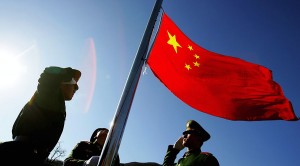
The historical evidence presented here shows that no one particular institutional form or political economic policy offers or accounts for success [nor failure!] in the competitive and ever changing world market. The contemporary evidence shows the same. In that respect, Deng Xiao-ping’s famous aphorism is correct.
The question is not whether cats are institutionally, let alone ideologically, black or white; the real world issue is whether or not they catch economic mice in competition with others in the world market. And that depends much less on the institutional color of the cat than it does on its opportune position in the world economy at each particular place and time. And since the obstacles and opportunities in the competitive world market change over time and in place, to succeed the economic cat, no matter what its color, must adapt to these changes or fail to catch any mice at all. Among these different institutional forms including relations among state-finance- productive and sales organizations, perhaps the most attention and positive evaluation has been devoted abroad to those of Korea and then of Japan but also of Greater China including its vast network of overseas Chinese. But the very fact that they differ, and in Taiwan, Singapore, Malaysia, Indonesia and elsewhere as well, should already forewarn us against privileging one institutional form over all others.
At best and that is already very much, the evidence is that none of these institutional forms is necessarily an impediment or insurmountable obstacle to success on the domestic, regional and world market. Most noteworthy perhaps in view of the widespread Western propaganda about its own alleged virtues is the demonstrated fact that no Western model need or should be followed by Asians in Asia or even elsewhere.
The significance of position and flexible response in the world economy is particularly important during periods of economic crisis B phase that is in Chinese of [negative] danger and [positive] opportunity. In the present economic crisis so far, the focus has been far too predominantly on its undoubtedly serious negative consequences. But the opportunities it poses have received insufficient attention, except perhaps in the United States and China, both of which are seeking to reap competitive advantages from the political economic problems and alleged meltdown of Japan, Korea, and Southeast Asia.
But the dismissal of East Asian and particularly Chinese economic strengths and prospects may be premature and certainly is based on a shortsighted neglect of the historical evidence as presented in my 1998 book ReORIENT and further pursued in my present work on the 19th century, as well as on a serious misreading of the contemporary evidence.
I believe that this latest quick dismissal of Asia is mistaken for the following reasons among others:
1] Since Asia and especially China was economically powerful in the world until relatively recently, and new scholarship now dates the decline as really beginning only in the second half of the nineteenth century, it is quite possible that it may soon be so again. Contrary to the Western mythology of the past century, Asian dominance in the world has so far been interrupted by an only relatively short period of only a century or at most a century and a half. The oft-alleged half century or more decline of China is purely mythological.
2] Chinese and other Asian economic success in the past was not based on Western ways; and much recent Asian economic success was not based on the Western model. Therefore, there is also no good reason why Japanese or other Asians need or should copy any Western or other model. Asians can manage their own ways and have no good reason to now replace them by Western ones as the alleged only way to get out of the present economic crisis. On the contrary, Asian reliance on other ways is a strength and not a weakness.
3] The fact that the present crisis visibly spread from the financial sector to the productive one does not mean that the latter is fundamentally weak. On the contrary, the present crisis of overproduction and excess capacity is evidence of the underlying strength of the productive sector, which can recover. Indeed, it was excess capacity and productivity leading to over-production for the world market that initiated the financial crisis to begin with when Asian foreign exchange earnings on commercial account were no longer able to finance its service of the speculative short run debt.
4] Not that economic recessions will or can be prevented in the future. They never have been prevented in the past even under state planning in China or the Soviet Union. More significant is that this is the first time in over a century that a world recession started not in the West and then moved eastward, but that instead it started in the East and then moved around the world from there. And that was precisely because as per # 3 East Asian and particularly Japanese, Korean and then Chinese productive and export capacity had grown so MUCH. This recession can therefore be read as evidence not so much of the temporary weakness as of the growing basic economic strength of East Asia to which the center of gravity of the world economy is now shifting back to where it had been before the Rise of the West.
5] The recession in the productive sector was short, especially in Korea., and so far absent in China. But it was also severe, especially in Indonesia. And the shock-waves from the financial sector to the productive, consumer and political ones were visibly – and to all but the totally blind, intentionally – exacerbated by the economic shock policies imposed on Asian governments by the IMF as usual following the dictates of the U.S. Treasury, which systematically represents American financial interests at the expense of popular ones elsewhere around the world. The former World Bank Vice-President, member of the US President’s Council of Economic advisers and now Nobel Prize laureate in economics, Joseph Stiglitz [2002], has given us an insider’s view of these intentional events in his GLOBALIZATION AND ITS DISCONTENTS.
That also permitted Western interests to take advantage of declines in productive and financial strength in Korea and elsewhere to buy up assets at bargain-basement fire-sale prices. Even so the underlying strength of the Korean economy was such that the foreigners were even then unable to alter the financial, productive, ownership and state structure significantly to their favor. The Korean productive and financial machine soon recovered again to forge ahead, but now with a costly lesson well learned. The lesson must have been learned elsewhere as well by comparing how relatively unscathed China and Malaysia [and as already mentioned for different reasons Korea] emerged from the financial crisis. They maintained controls over capital exports, compared to those countries that succumbed to the IMF and its lethal medicine by permitting a speculative capital outflow, which destroyed their productive apparatus and multiplied unemployment into an unbearable economic, social, and political problem, especially in Indonesia.
6] That underlying political economic strength also puts East Asia, and especially China, Japan and Korea in a much more favorable position than the rest of the Third World and even Russia and Eastern Europe to resist Western blackmail as it is now exercised by the U.S. Treasury Department through the International Monetary Fund, the World Bank, the World Trade Organization, Wall Street and other instruments.
7] The very act and cost of East Asian concessions to this Western pressure during the past recession makes it politically more likely, since it is economically possible, that East Asia will take measures, including especially a new financial bloc and banking institutions, that can prevent a recurrence of the present situation in the future by escaping from the strangle-hold of Western controlled capital markets. Stiglitz observes such efforts already in his recent private discussions with Asian officials as reported in his book.
8]. Indeed, one of the present battles, first by the Japanese and now also by the Chinese, is to remodel the world financial and trade institutions that were designed by the United States to work in its favor. Thus, Japan wanted to establish an Asian monetary fund to prevent the East Asian recession from deepening as it has thanks to the International Monetary Fund based in and subservient to Washington. And China wishes to join the World Trade Organization but also seeks to have this Western dominated institution reformed to its advantage.
9] A related political economic struggle is the competition between the United States and China to displace Japan, Korea and Southeast Asia in the market by taking advantage of their bankruptcies. American capital is buying up some East Asian productive facilities at bargain basement prices, while China is waiting for them either to be squeezed out of the competitive market altogether, and if not to engage in joint operations. Indeed it had been the devaluation of the Chinese currency before 1997 that reduced the world market share of other Asian economies and helped generate the financial crisis itself. Only time will tell which strategy will be more successful, but the Chinese and perhaps also some Southeast Asians seem like the better bet over the long term. Moreover, no matter how deep the recession in Japan; it is not for that eliminated as an economic power, especially in Asia. However, there is evidence that China is trying to reconstruct the East Asian trade and tribute system at whose center it was in the eighteenth and that the ern colonial powers dismantled in the nineteenth century.
10] Equally significant is that India and to recently to a lesser extent China have remained substantially immune from the present recession, thanks in part to the inconvertibility of their remin ribao and rupee currencies and the valve in their capital markets that permits the inflow but controls the outflow of capital. The currency devaluations of China’’s competitors elsewhere in East Asia and the reduced inflow into China of Overseas Chinese and Japanese capital that is negatively affected by the recession in East Asia may oblige China to devalue again as well to remain competitive. Nonetheless and despite their serious economic problems, the Chinese and Japanese economies appear already to have and to continue to be able to become sufficiently productively and competitively strong to resist and overcome these problems. In Southeast Asia, Malaysia has successfully followed the Chinese model of opening its capital market to inflows but restricting especially speculative capital outflows from the same. Korea did not need such emergency measures, since it had received relatively little foreign capital to begin with.
11] Regarding the mainland Chinese economy, the President of the Chinese Society of World Economy, Pu Shan, observed already the in the mid 1990s:
Results of the economic reform are remarkable. Real gross national product in 1995 increased 4 times that of 1980, with an average annual growth rate close to 10% during that period. Real income peer capita more than tripled. Exports and imports of merchandize trade in 1995 increased more than 7 times that of 1980 in terms of U.S. dollars, while China’s share in world trade more than tripled And China became the largest recipient lf foreign direct investment among developing countries. It is also noteworthy that the large scale transfer of agricultural labor to industry has been accomplished amind unprecedented prosperity in the rural economy, unlike many other countries that went through the painful process of widespread bankruptcy of farmers (Pu 2004: 174].
In the decade since then, most of these trends have still continued, though the rural economy and agricultural income have lagged. In particular however, the ten percent annual growth rate has still been maintained, which means doubling in size in six years, soon to become the world’s second largest after that of the United States.
But China now also holds the greatest single share of the huge and ever growing American foreign debt, although it is doubtful that anyone will ever be able to collect on any substantial part of it.
Nor does this mean that China’s growth does not also pose immense problems, from gaping inequality between the coast and the interior or urban and rural, or its growing demand and import of raw materials and especially oil and soon of foodstuffs, and the menacing shortage of water.
Japan’s major fiscal and economic crisis of the 1990s has abated and economic performance and prospects have improved again despite the continuing debt overlag. As to India, although its growth has been lagging behind, it has recently increased and shows promise or at least possibility of further acceleration: from 1.5 percent annually during the three decades following independence to 5.5 percent over all and 3.5 percent per capita in the 1980s, and 6 and 4 percent respectively in the 1990s. For the next half decade, projections range from 5 to 7.5 percent annually. That is still less than for East Asia, but sufficient to double in a decade or so. All of these Asian medium term growth rates exceed by far those ever previously achieved anywhere in the West.
It is noteworthy that the economically most dynamic regions of East Asia today are also still or again exactly the same ones as before 1800 and which survived into the nineteenth century.
– 1. In the South, Lingnan centered on the Hong Kong – Guangzhou corridor,
– 2. Fujian, still centered on Amoy/Xiamen and focusing on the Taiwan straits and all of Southeast Asia in the South China Sea; and between them,
– 3. the Yangtze Valley, centered on Shanghai and trade with Japan that is already taking the lead away again from the southern and northern regions.
– 4. But already then there was also a fourth economic region around the North China Sea, the quadrangular trade relations among Manchuria and elsewhere in Northeast China, Siberia/Russian Far East, [northern?] Japan, and Korea, but also including Mongolia..
Although the first three above-named regions are already again undergoing tremendous economic growth [and political power?] in the absolute sense, the fourth one around Korea seems to enjoy the greatest relative boom, and within it that of Korean capital as well. It is helping to develop resources in the Russian Far East and as far west as Central Asian Khazhakstan. The Chinese population on the Russian side of the Amur River has been estimated already to exceed 5 million people as a pool of cheap labor.
Probable political change in the DRNK may well add a new source of cheap labor for this growing pool of labor in the Northeast Asian Region and for its Far East Russian also cheap base of ample metallurgical, forestry, agricultural and even petroleum resources. Korean and Japanese capital could make that a very attractive regional growth pole in itself and a highly competitive region on the world market.
All of these in turn were and still or again increasingly are important segments of world trade and of the global economy.
In that sense also the examination of the world economy and of the predominant place in it of the East Asian including the Korean economies points to the most fundamental bases of contemporary economic developments in the region and also presages important world economic ones for the foreseeable future.
The late Prof. André Gunder Frank was an outstanding political economist and historian He passed away in April 2005. His legacy will live.
At the time of writing he was an Associate of the Luxembourg Institute for European and International Studies, Luxembourg and Senior Fellow, World History Center, Northeastern University, Boston, Mass.
For details on André Gunder Frank`s writings, see http://rrojasdatabank.info/agfrank/index.html


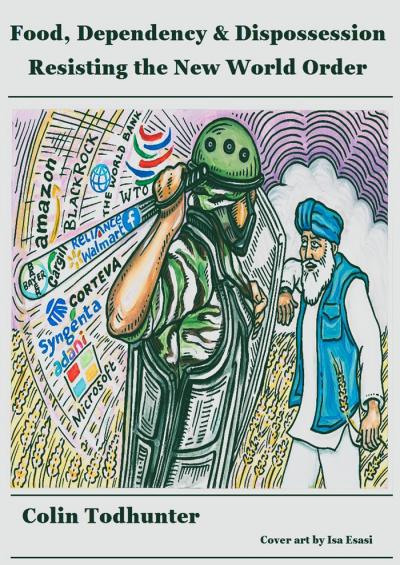 Read Colin Todhunter’s e-Book entitled
Read Colin Todhunter’s e-Book entitled
 Dear Friends, Sorry to Announce a Genocide: Dr. Naomi Wolf on the Pfizer “Confidential Report”
Dear Friends, Sorry to Announce a Genocide: Dr. Naomi Wolf on the Pfizer “Confidential Report” Bayer Head Admits COVID-19 Vaccine Is Gene Therapy
Bayer Head Admits COVID-19 Vaccine Is Gene Therapy Black Sea Geopolitics and Russia’s Control of Strategic Waterways: The Kerch Strait and the Sea of Azov
Black Sea Geopolitics and Russia’s Control of Strategic Waterways: The Kerch Strait and the Sea of Azov Video: The Plan. WHO Plans to Have 10 Years of Pandemics (2020-2030). “Proof that the Pandemic was Planned with a Purpose”
Video: The Plan. WHO Plans to Have 10 Years of Pandemics (2020-2030). “Proof that the Pandemic was Planned with a Purpose” We’re Now in the Last Stage of a Tyrannical Takeover
We’re Now in the Last Stage of a Tyrannical Takeover Video: Pfizer’s “Secret” Report on the Covid Vaccine. Beyond Manslaughter. The Evidence is Overwhelming. The Vaccine Should Be Immediately Withdrawn Worldwide
Video: Pfizer’s “Secret” Report on the Covid Vaccine. Beyond Manslaughter. The Evidence is Overwhelming. The Vaccine Should Be Immediately Withdrawn Worldwide Kissinger Nails It. For Once.
Kissinger Nails It. For Once. The Devastating Impacts of the COVID-19 Vaccine Confirmed: We Were Lied to: Game Over, We Won. Steve Kirsch
The Devastating Impacts of the COVID-19 Vaccine Confirmed: We Were Lied to: Game Over, We Won. Steve Kirsch Study Finds Athlete Deaths Are 1,700% Higher Than Expected Since COVID-19 Vaccination Began
Study Finds Athlete Deaths Are 1,700% Higher Than Expected Since COVID-19 Vaccination Began The Top Ten Creepiest and Most Dystopian Things Pushed by the World Economic Forum (WEF)
The Top Ten Creepiest and Most Dystopian Things Pushed by the World Economic Forum (WEF) Bilderberg Meets in Washington: Bilderberg Does China. An Economic Hurricane is Coming
Bilderberg Meets in Washington: Bilderberg Does China. An Economic Hurricane is Coming New Zealand Doctors Speaking Out on Deaths Following Vaccination – “Let’s make our police and MPs put a stop to this now!”
New Zealand Doctors Speaking Out on Deaths Following Vaccination – “Let’s make our police and MPs put a stop to this now!” The COVID Pandemic and the mRNA Vaccine: What Is the Truth? Dr. Russell L. Blaylock
The COVID Pandemic and the mRNA Vaccine: What Is the Truth? Dr. Russell L. Blaylock Reality vs. Illusion. People have been Robbed of their Ability to “Decipher between Fact and Fiction”
Reality vs. Illusion. People have been Robbed of their Ability to “Decipher between Fact and Fiction” Why America Needs War
Why America Needs War Monkey Pox Update: “War Game” Scenario Planning. “The Controlled Media Have No Shame”. Dr. Robert Malone
Monkey Pox Update: “War Game” Scenario Planning. “The Controlled Media Have No Shame”. Dr. Robert Malone The Pandemic Treaty: WHO Suffers Defeat as Countries Massively Oppose Globalist Plans
The Pandemic Treaty: WHO Suffers Defeat as Countries Massively Oppose Globalist Plans Video: Digital Tyranny and the QR Code. The WHO Pandemic Treaty is the Back Door to “Global Governance”
Video: Digital Tyranny and the QR Code. The WHO Pandemic Treaty is the Back Door to “Global Governance” The Links Between Jeffrey Epstein and Bill Gates Explained
The Links Between Jeffrey Epstein and Bill Gates Explained A New War in the Middle East? Israel Military Exercises Simulates Invasion of Lebanon, War with Hezbollah, and Iran
A New War in the Middle East? Israel Military Exercises Simulates Invasion of Lebanon, War with Hezbollah, and Iran The Mysterious Death of Osama bin Laden
The Mysterious Death of Osama bin Laden Rethinking the Second Amendment. “Those Lost to Gun Violence”: Dr. Naomi Wolf
Rethinking the Second Amendment. “Those Lost to Gun Violence”: Dr. Naomi Wolf Scott Ritter: Phase Three in Ukraine
Scott Ritter: Phase Three in Ukraine Study Finds Latest Monkeypox Outbreak Is Result of Biolab-manipulated Virus Possibly Released Intentionally
Study Finds Latest Monkeypox Outbreak Is Result of Biolab-manipulated Virus Possibly Released Intentionally






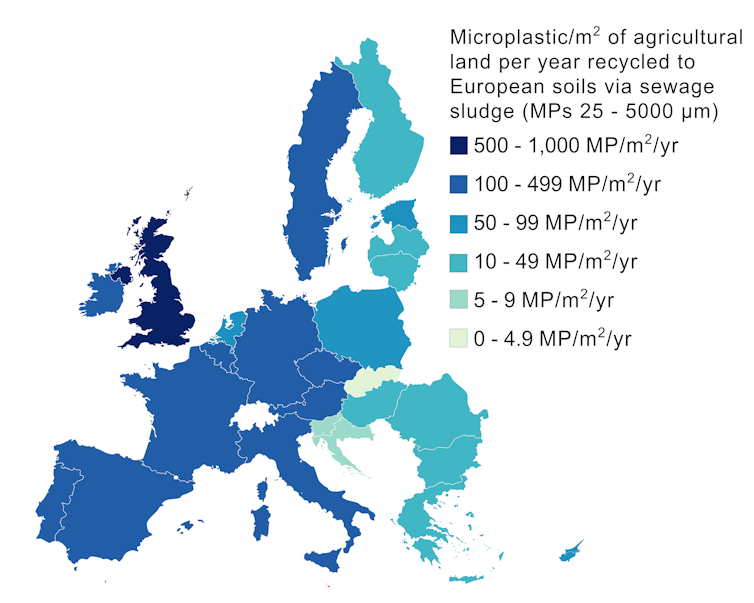
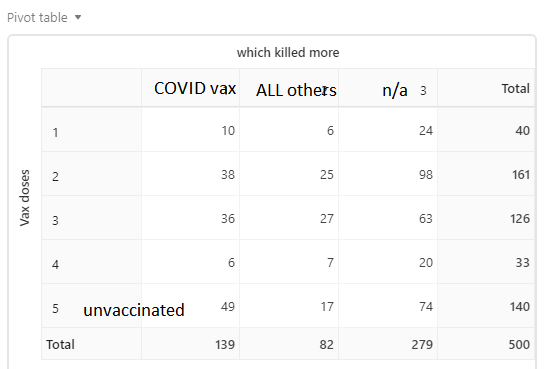


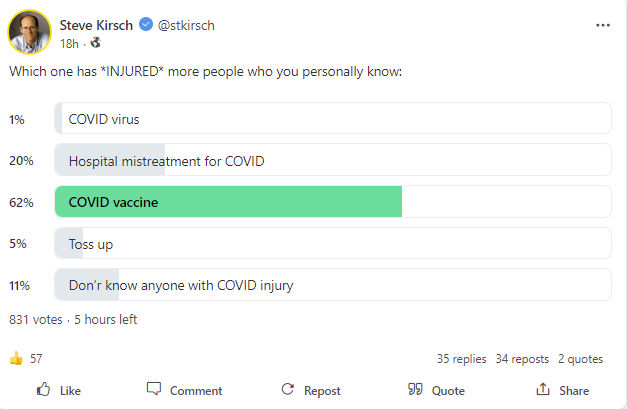
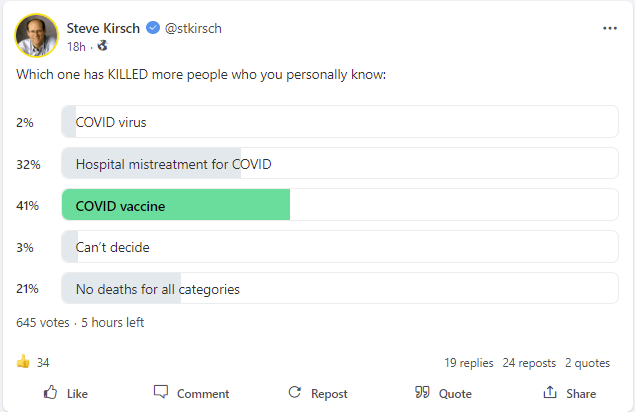









 And beware of PNAC, the Project for a New American Century, which was already lobbying Washington with their plans for a “Pax Americana” in 1992, 1997, and 2000 among other notable dates.
And beware of PNAC, the Project for a New American Century, which was already lobbying Washington with their plans for a “Pax Americana” in 1992, 1997, and 2000 among other notable dates.



